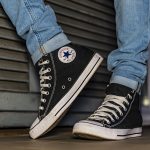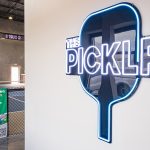Nike shares climbed 10.5% last week, setting a new 52-week high at $61.50 at the close on Friday. Shares had opened higher on Friday after rising 4% in after-hours Thursday trading on news that the company had beaten Wall Street fiscal Q1 earnings estimates by 10 cents a share.
The earnings performance for the quarter — and a better-than-expected spring order backlog appeared to overshadow the continued softness in the U.S. business, impacted by a 34% decrease in business at Foot Locker and lower average selling prices.
Nike, Inc. reported that revenues for the fiscal first quarter ended August 31, 2003 increased 8.2% to $3.0 billion, versus $2.8 billion for the same period last year. Sales rose 17% in Europe, but were off 2% in constant currency. Sales were also down 2% in the U.S. but up 13% in Asia and up 8% in the Americas. U.S. non-Foot Locker sales were up 2.0%.
The company still expects its business with Foot Locker to be down for the balance of calendar 2003, but spring futures are up for the season-to-date.
Total company futures were up 10.5%, but Nike noted that much of the gain was due to currency conversion and earlier spring launches in Europe. U.S. futures were down 3.0%, but total International futures jumped 23%, with Europe showing a 28% gain, or 21% on a constant currency basis. Asia futures grew 19%, or 17% currency neutral, and the Americas region gained 9%, or 6% on a currency neutral basis.
The 30-day forward shift of some EMEA spring product to January 2004 delivery also accounts for about 4% to 5% of the backlog gain. This will balance out a bit after bookings are closed on February futures. These orders represent a significant acceleration of the futures trend over the last several quarters, particularly in the second half of the futures window.
Lehman Brothers analyst Robert Drbul, raised his price target to $68 from $62, due in part to better-than-expected backlog. He said he had expected a 4% to 6% decline in U.S. futures.
Dennis Rosenberg, a Credit Suisse First Boston analyst, raised his price target to $70 from $60.
J.P. Morgan analyst Noelle Grainger, pointing out that Nike is more confident with its fiscal 2004 outlook, raised her price target to $65 from $60.
“We believe Nike's first quarter results confirm that our thesis calling for a U.S. recovery in 2003, sustainable global growth and long-term margin expansion is beginning to play out.” Grainger said in a report.
Nike seems to be quite comfortable in their own skin in the U.S. now, accepting tepid sales growth in favor of improved margins, increasing earnings and brand preservation. They are very focused on presentation of the brand at retail and appear determined to stay the course they laid out last year.
The result appears to be lowered U.S. top-line expectations by the “street”, offset a bit by currency exchange rates that drive the International numbers higher. Both issues are coming into a one-year anniversary period where the U.S. business will be compared to post-Foot Locker-spat results in the U.S. and the exchange rate fluctuations diminish with a stabilizing exchange rate.
The company appears to once again be looking at the long-term goal here, not unlike the period in the late eighties when they pulled back to re-position themselves operationally for the big push that propelled them into stratospheric growth results for more than a decade. The focus now is clearly on the bottom line, delivering earnings growth that will continue to outpace sales growth.
Nike said it still expects full-year EPS growth in the mid teens, and sees revenue increasing in the high-single digits.
First quarter net income totaled $261.2 million, or 98 cents per diluted share, compared to a loss of $48.9 million, or 18 cents loss per diluted share, due to $266.1 million in accounting adjustments. Excluding the accounting change, net income would have been 20.2% higher than non-adjusted net income of $217.2 million, or 81 cents per diluted share, in the year-ago period. Pretax profit margin for the quarter exceeded 13% for the first time since Q1 1998.
Gross margin rose by 160 basis points to 43.0% due to improvements in supply chain execution and “cleaner” inventories that drove about 75% of the margin gains, while the stronger Euro contributed the balance. Gross margins for Nike Brand footwear were up 200 basis points from the prior year quarter, contributing 100 basis points to the total gross margin gain.
On a regional basis, the EMEA unit, which includes Europe, the Middle East and Africa, saw gross margin improve by 210 basis points, accounting for 70 basis points of the consolidated margin improvement. The weaker dollar/stronger Euro was the key factor here, delivering 130 basis points of the EMEA gain. Asia-Pacific GM increased 80 basis points, accounting for 10 basis points of the gross margin improvement. The Asia-Pacific margin increase was largely the result of higher in-line margins across footwear, apparel and equipment.
In the U.S., gross margins also grew 210 basis points, hitting 43.7% of sales. Over half of the region's gross margin expansion came from higher wholesale footwear margins, with the balance contributed by higher gross margins in wholesale apparel and equipment and Nike Retail. The gain contributed 90 basis points of improvement in Nike Inc.'s consolidated gross margin. Pretax profits grew 4% in the region.
U.S. footwear sales declined 5.0% in the quarter while apparel sales rose by the same percentage rate. The company said growth in performance apparel and licensed products, particularly college retro looks, “more than offset” lower “active life” apparel sales.
In apparel, Nike is experiencing much of the same shift the rest of the market is seeing. While overall U.S. apparel sales are higher, much of the gains came in the Licensed product side of the business, fed by the current retro jersey trend.
The results are also evident in apparel futures, which were down at the end of the quarter. The company explained that the shift in dollars to Licensed apparel was responsible for much of the decline as though numbers are not booked on the same futures timelines as Branded apparel. It is more of an “at-once” business. Still, Nike is also working to re-define the Branded business at retail, pointing to “improved presentation distribution” as reason for the lower futures as well.
If we read between the lines, Nike appears to be experiencing some pains as they work to convert some of the commodity apparel business to better product, primarily in performance. The philosophical stake-in-the-ground is the same in footwear as it is in apparel.
“It is our intent to continue to concentrate on how our brand is presented to the consumer; to improve the presentation of both footwear and apparel; partner with the new and innovative retailers that create a compelling shopping environment; and believe that brand building is the key to success in this industry,” said Nike Brand co-president Charlie Denson in a call with analysts.
The conversation here is highlighted by the relationship with Foot Locker and the shifting of Marquee product to other retailers, both in the mall and at the street level.
Denson went on the say that Foot Locker was “looking at their formats” and discussing “how they might fit into where we want to go”. He said that although Foot Locker has “expectations” to get back into the “marquee product zone”, Nike has not set any timelines or made any changes to its distribution policy to date.
He characterized the dialog as “much healthier” than it was a year ago, probably due to the fact each has turned down the public rhetoric quite a bit since the original salvos were fired last fall.
He also stressed that Nike was having “considerable success” with other retail partners, “both big and small” that makes them feel good “improving condition of our brand at retail.”
“Footstar is not our second biggest customer”, said CFO Don Blair in response to an analyst question on the call. “And with respect to the business relationship with Footstar, at this point our sales performance has been very good with Footstar. And our accounts receivable are current. And we're not seeing any issues in terms of liquidity or other financial issues at this point coming through Footstar.” The quasi-endorsement appeared to be good news for the folks at Footstar, as shares stabilized a bit on Friday after a very rough week.
Revenues from non-Nike Brand businesses grew 32% for the quarter. Nike Golf revenues grew over 40% and Bauer Nike Hockey and Hurley each gained about 30%. Cole Haan posted 14% growth for Q1.
Worldwide inventories were up 3.9%, or $56 million higher than the prior year. The stronger Euro accounted for approximately $39 million of the growth. Inventory in the U.S. was flat versus the prior year.
>>> Unfortunately, Nike is one of very few public company brands that can make these kinds of moves and not get taken to the shed
>>> The whole industry wins if the brands continue to stay strong for the long-term…













